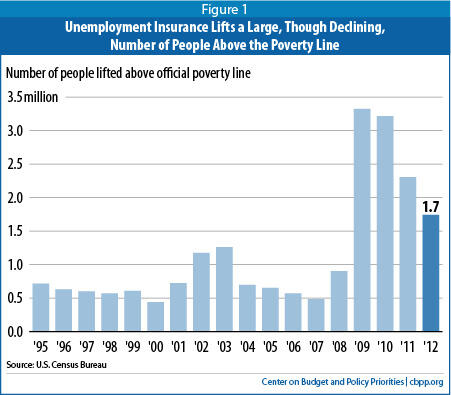- Home
- Why Isn't Poverty Falling? Weakening Of ...
Why Isn't Poverty Falling? Weakening of Unemployment Insurance Is a Pivotal Factor
The poverty rate remained unchanged at a high 15.0 percent in 2012, the third full year of an economic recovery that officially began in June 2009. One key reason why poverty has remained virtually frozen despite continued economic growth is the weakening of unemployment insurance (UI). If UI had not become less effective at reducing poverty among unemployed workers between 2010 and 2012, the poverty rate would have fallen over that period to 14.7 percent, CBPP calculations show. UI will become still less effective if Congress fails to extend emergency benefits for the long-term unemployed, which expire at the end of December.
UI benefits kept 1.7 million people — jobless workers and their families — above the poverty line in 2012, according to Census figures released in September.[1] This was 600,000 fewer than in 2011 and 1.5 million fewer than in 2010 (see Figure 1).

The chief reason for the decline is the dwindling likelihood that an unemployed worker will receive UI. The number of UI recipients for every 100 unemployed workers fell from 67 in 2010 to 57 in 2011 and 48 in 2012.
In fact, while the number of jobless workers has been falling, the number of jobless workers who receive no UI benefits has been rising and is higher now than at the bottom of the recession in 2009.
This too-quick retreat on UI benefits is pushing upward on poverty, as the following calculations show:
- If the number of UI recipients were only falling because unemployment was falling, one might reasonably expect the two to decline at about the same rate. The number of unemployed people fell by 16 percent from 2010 to 2012. UI kept 3.2 million people out of poverty in 2010, so a 16 percent reduction means it would have protected 2.7 million people from poverty in 2012.
- In reality, however, UI kept only 1.7 million out of poverty last year. That implies that the weakening of UI added 1 million people to the ranks of the poor, or 0.3 percentage points to the poverty rate.
- In other words, the 2012 poverty rate would have been 14.7 percent, rather than 15.0 percent, if UI’s poverty protection per unemployed worker had remained what it was in 2010. That would have been a statistically significant improvement from 2010’s 15.1 percent.
The share of unemployed workers getting UI fell for several reasons. First, the length and depth of the jobs slump has left many workers unable to find work before their UI benefits run out. Second, several states have cut the number of weeks of regular, state-funded UI benefits.
A third and critical reason is that in 2012, Congress provided fewer weeks of federal UI benefits, which go to long-term unemployed workers. It cut the number of weeks of federal UI benefits provided through one UI program (Emergency Unemployment Compensation or EUC) and chose not to take steps it had taken in the past to continue access to another federal UI program (Extended Benefits), which as a result is essentially no longer available.
What’s left of federal UI (the EUC program) is scheduled to expire at the end of December. If Congress does not extend it, all long-term unemployed workers receiving EUC will be cut off at that point, and other workers who qualify for UI will be limited to whatever their state’s regular UI program provides — 26 weeks in most states.
End Notes
[1] See Arloc Sherman, Danilo Trisi, and Matt Broaddus, “Census Data Show Poverty and Inequality Remained High in 2012 and Median Income Was Stagnant, But Fewer Americans Were Uninsured,” Center on Budget and Policy Priorities, September 20, 2013, https://www.cbpp.org/cms/index.cfm?fa=view&id=4022.
More from the Authors
